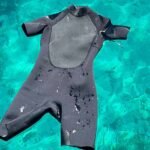Wetsuits are your second skin in cold water, shielding you from chills and allowing you to surf, dive, or paddle in comfort. But without proper care, that protective layer can degrade fast—fading, stretching, or even tearing over time.
To wash a neoprene wetsuit effectively, start by rinsing it inside and out with fresh, lukewarm water. Use a mild, neoprene-safe detergent (or a specialized wetsuit shampoo) at recommended concentrations. Gently hand-wash with soft strokes, avoid wringing, then rinse thoroughly. Hang to drip-dry in the shade, ensuring proper air circulation. This routine keeps your suit odor-free and performance-ready.
I still remember the first time my favorite suit shrank overnight in the sun—ruining an epic surf trip. Stick around, and I’ll show you how to avoid that rookie mistake and keep your wetsuit feeling like new, wave after wave.
What Pre-Wash Preparations Protect Your Neoprene Wetsuit?
Before you even get to soap and water, preparation is key: flush out sand, salt, and chlorine with a quick fresh-water rinse, unzip every closure, and turn the suit inside-out. This lets debris escape and detergent penetrate evenly, preventing grit from scratching the neoprene’s interior. Dry off excess moisture with your hands—never wring—and lay the suit flat to cool down for five minutes before cleaning.
- Remove Debris and Fastenings.
- Rinse Immediately: Right after exiting the water, rinse your suit with fresh tap water. Salt crystals, sand grains, and pool chemicals can weaken seams and degrade material if left to dry on neoprene’s surface.
- Unzip and Flip: Unzip all zippers—back, chest, ankle—so that you can rinse both sides of the material thoroughly. Turning your suit inside-out exposes the lining, which often traps more salt and bacteria than the exterior.
- Inspect for Damage.
- Before washing, do a quick check for tears, loose seams, or delaminating panels. Minor rips can be patched after a wash; letting detergent sit on unrepaired neoprene can worsen damage.
- Temperature Considerations.
- Avoid Heat Shock: Never expose a warm, sun-baked suit directly to cold water. Allow the suit to cool in the shade for at least five minutes. Rapid temperature changes risk warping the neoprene’s cellular structure and causing stiffness or cracking.
- Prepare Your Wash Station.
- Shallow Tub or Sink: Use a dedicated basin—never your kitchen sink. Fill with 10 – 15 L of water at 25 – 30 °C (77 – 86 °F). This volume ensures enough circulation for the suit, helping detergent move freely around it.
- Detergent Placement: Have your neoprene cleaner measured out and ready to go. Over-concentrating can leave residue; too weak, and you won’t eliminate odors and oils effectively.
Which Detergents and Additives Are Safe for Neoprene?
Not all soaps are created equal—harsh detergents strip neoprene’s vital oils, causing cracks and stiffness. Opt for pH-neutral, biodegradable wetsuit shampoos or very mild dish soap without bleach, fragrances, or brighteners. Dilute at 1 – 2 mL per liter of water. For extra odor control, add 1 – 2 tablespoons of white vinegar or a specialized antibacterial wetsuit rinse. Avoid fabric softeners—these clog neoprene’s pores and reduce flexibility.
Chemical Compatibility
- pH Neutrality: Neoprene performs best around pH 7. Soaps with pH below 6 or above 8 can attack neoprene’s bonds. Always check labels for “pH 7” or “biodegradable neoprene safe.”
- Enzyme Cleaners: Some wetsuit shampoos contain proteolytic enzymes that target protein-based grime (like sunscreen and sweat). These are generally safe but may accelerate wear if overused—limit enzyme treatments to once per 5–10 washes.
Cost vs. Performance
| Product Type | Typical Cost (USD per L) | pH | Biodegradable? | Notes |
|---|---|---|---|---|
| Neoprene-Safe Wetsuit Wash | 15 – 25 | 6.5–7.5 | Yes | Formulated specifically, odor control |
| Mild Dish Soap (unscented) | 3 – 6 | 7.0 | Varies | Cheap, but risk of residue |
| White Vinegar Additive | 1 – 3 | 2.4 | Yes | Use sparingly for mildew control |
Avoiding Harmful Additives
- No Bleach or Brighteners: These oxidizers degrade neoprene rubber molecules, leading to brittleness.
- No Fabric Softeners: While they make fabrics soft, they coat neoprene cells, reducing breathability and thermal properties.
- Fragrance Risks: Fragile fragrance oils bind to neoprene and can attract more dirt over time.
DIY Natural Alternatives
- Tea Tree Oil: A few drops can inhibit mildew growth—but test on a hidden panel first to rule out discoloration.
- Baking Soda Paste: For localized odor spots, make a 1:2 baking soda–water paste. Gently rub, wait 5 minutes, then rinse thoroughly.
How Do You Hand-Wash a Neoprene Wetsuit Step by Step?
Hand-washing is the gold standard: submerge your suit in lukewarm, detergent-laced water, gently agitate for 2–3 minutes, focusing on high-wear areas (underarms, collar, cuffs). Never scrub with brushes—use your palms and fingertips. After cleaning, drain and refill with fresh water to rinse. Press out water by rolling the suit in a towel—no wringing. This gentle process preserves neoprene’s integrity and flexibility.
- Submersion & Soak.
- Initial Soak: Let the suit float freely for 5–7 minutes to allow detergent to penetrate all layers. Pushing down on the suit with your hand helps dislodge trapped air and grime.
- Targeted Agitation: Lift and fold the suit like washing a delicate blouse—lift the legs, arms, and torso in cycles, ensuring detergent passes through every seam and panel.
- Gentle Spot Cleaning.
- Inside Collar & Cuffs: These areas trap sweat and oils. Use a soft microfiber cloth dampened with cleaner to gently swipe along these seams.
- Avoid Brushes: Bristles can tear jersey linings or abrade the latex surface underneath, weakening the wetsuit structure.
- Rinsing Technique.
- Two-Step Rinse:
- Partial Drain & Refill: Remove the soapy water, add fresh water, and gently agitate.
- Final Flush: Tip the basin to fully drain—run fresh water over the suit to wash away any last suds. Listen: no more bubbles means you’re done.
- Two-Step Rinse:
- Water Removal Without Wringing.
- Towel Roll: Lay the wetsuit flat on a large bath towel. Roll like a sushi mat, pressing gently to absorb water. Repeat with a dry section of towel until the neoprene feels damp, not wet.
- Air Press Technique: Lay suit facedown on a dry towel, then lay your hand flat on the back to press out pools of water. Repeat on the other side.
Is Machine Washing Safe—and Which Settings Should You Choose?
Machine washing is generally discouraged but can be acceptable if you have a dedicated “delicates” or “hand-wash” cycle, cold water only, and no spin cycle. Use a mesh garment bag and the mildest detergent. Skip high-speed spins—set spin at or below 400 RPM. Immediately remove the suit after the cycle to prevent creasing. Always follow the manufacturer’s care tag.
Pros & Cons of Machine Washing.
- Pros: Convenience, consistent water temperature, reduced manual effort.
- Cons: Agitation forces can stress seams, spin cycles may warp or overstretch neoprene, and leftover lint from other clothes can embed in the fabric.
Recommended Washer Settings.
- Cycle: “Hand-wash” or “Delicates.”
- Water Temp: Cold (≤ 20 °C / 68 °F) to prevent thermal shock.
- Spin Speed: ≤ 400 RPM. Anything higher risks creating stretch marks or distorting panel shapes.
- Load: Wash the wetsuit alone or with other neoprene accessories (boots, gloves) to balance the drum and avoid contact with abrasive items.
Protective Measures.
- Mesh Bag: Use a large, fine-mesh laundry bag to cushion the suit and prevent zipper snags.
- Zip Protector: Slide a rubber gasket or cloth over the teeth to protect the jersey lining during spin.
Post-Machine Cycle Protocol.
- Immediate Removal: Don’t let the suit sit; residual moisture trapped in folds can breed mildew and bacteria within hours.
- Quick Rinse: Even after machine wash, I recommend a brief fresh-water rinse to whisk away any remaining detergent residue.
How Do You Rinse and Remove Excess Water Without Damage?
Rinsing is as critical as washing: after soapy water, refill your basin with clean lukewarm water, submerge, gently agitate for 1 – 2 minutes, then drain. To remove excess water, use the towel-rolling method—lay the suit flat on a large towel, roll it up tight, and press firmly. Repeat with a second dry towel until damp. Never twist or wring the suit; this stretches and creases the neoprene cells, leading to cracks and permanent deformations.
Multi-Stage Rinse Process
- Stage 1: Fill halfway with fresh water, fold the suit in on itself, and gently move it back and forth to flush out soap pockets along seams.
- Stage 2: Drain, refill fully, and lightly submerge the entire suit. Lift arms and legs a few times to force water through every layer.
Why Wringing Fails
- Cellular Damage: Neoprene is made of millions of gas-filled cells; wringing compresses these cells irregularly, causing microfractures.
- Seam Stress: Sudden torsion places uneven tension on glued or stitched seams, leading to delamination.
Towel Rolling in Depth
- Towel Choice: Use large, fluffy cotton towels—microfiber towels tend to hold water against the neoprene rather than lifting it away.
- Pressure Technique: Roll from one end, applying gentle, uniform pressure. Unroll, reposition to a dry section, and re-roll.
Alternative Water Extraction
- Air Press (Hands-Only): Lay the suit flat and “press” out water using the palm of your hand, moving in sweeping motions from top to bottom. This method works well for light wetsuits (1–3 mm) that can’t support a heavy towel roll.
What Drying Techniques Preserve Shape and Flexibility?
Hang your neoprene wetsuit inside-out on a wide, non-metal hanger in the shade, ensuring it’s fully unzipped. Avoid direct sunlight, radiators, or tumble dryers. Let it drip-dry for 12–24 hours in a well-ventilated area at 18–24 °C (65–75 °F). Once the outside is dry, flip it right-side-out to finish. This gentle air-dry approach maintains panel alignment, elasticity, and thermal properties without stress.
Ideal Drying Environment
- Temperature & Humidity: Aim for moderate indoor conditions (18–24 °C, 40–60% RH). High humidity slows drying and can encourage mold; too low accelerates drying too fast, risking brittleness.
- Airflow: Position near a gentle fan or open window—cross-ventilation shortens dry times and reduces odor build-up.
Hanger Selection & Position
- Wide Plastic or Wooden Hanger: Metal thin hangers create shoulder dents; curved hangers distribute weight more evenly.
- Inside-Out First: Flipping the suit inside-out exposes the lining, which retains moisture longer than the outer skin. After 6–8 hours, reverse the suit to allow the latex/nitrile side to dry.
Sunlight & Heat Exposure Risks
- UV Degradation: Even indirect UV rays cause neoprene to yellow and lose tensile strength.
- Heat Sources: Never use heaters, hairdryers, or tumble dryers. Rapid heat dries the neoprene unevenly, leading to shrinkage—especially around thin seams.
Speedy Drying Hacks (Use Sparingly)
- Wetsuit Drying Rack: If you have multiple suits, invest in a drip-rack with wide bars that support both shoulder and torso panels.
- Absorbent Mesh Liner: Slip a mesh liner between the suit layers while drying. The liner wicks moisture away faster—remove once the suit is touch-dry.
How Often Should You Wash Your Wetsuit for Peak Performance?
Wash after every 5–10 hours of use—or more often if you’re in chlorinated pools or polluted waters. For saltwater sessions, a fresh rinse suffices every trip, but a full wash helps remove oils, sunscreen, and bacteria that degrade neoprene. Competitive surfers or divers should deep-clean weekly. Excessive washing can strip natural neoprene oils; under-washing leads to odors and material fatigue. Balance is key.
Usage-Based Frequency Table
| Environment | Session Count Before Wash | Rinse-Only Interval | Notes |
|---|---|---|---|
| Saltwater Ocean | 5–8 | Every session | Rinse to remove salt; wash weekly |
| Chlorinated Pool | 3–5 | Every session | Chlorine is harsh—full wash bi-weekly |
| Freshwater Lakes/Rivers | 8–12 | Every 2 sessions | Fewer chemicals, but watch for algae |
| Heavy Sweat (Tropical) | 3–4 | Every session | Sweat salts can accelerate decay |
Signs You Need to Wash Sooner
- Odor Threshold: A sour or fishy smell signals bacterial growth.
- Stiff Seams & Panels: If the suit feels gummy or sticky inside, residual detergent or grime may be the culprit.
Risks of Over-Washing
- Oil Strip-Out: Each wash removes trace amounts of neoprene’s built-in oils—over time, this leads to cracking.
- Color Fade: Frequent exposure to water and soap dulls dyed panels, especially reds and blues.
Maintenance Between Washes
- Post-Session Rinse: Always rinse with fresh water right after use to prevent salt and chlorine buildup.
- Light Freshener Sprays: Use a dedicated neoprene refresher spray to inhibit odors between washes—avoid sprays with alcohol or harsh solvents.
What Post-Wash Storage Practices Extend Your Wetsuit’s Lifespan?
Store your wetsuit unzipped, inside-out, on a broad hanger in a cool, dark place. Avoid cramped closets, direct sunlight, and folded piles. For long-term storage (off-season), place in a breathable garment bag or sling; do not compress or weigh it down. Every few weeks, air it out to prevent mold. Proper storage maintains panel alignment, prevents creases, and protects neoprene’s thermal qualities.
Optimal Storage Conditions
- Temperature Control: Keep between 10–20 °C (50–68 °F). Heat speeds up chemical breakdown; extreme cold can make neoprene brittle.
- Humidity Levels: Aim for 40–60% RH. Too dry causes fabric to stiffen; too humid encourages mildew.
Hanger vs. Sling vs. Fold
- Hanger (Daily Use): Wide, plastic/wood hangers support the suit at the shoulders, preventing sagging. Always unzip to relieve stress on teeth.
- Sling (Long-Term): A wetsuit sling—thin nylon webbing that cradles the torso and legs—avoids shoulder dents. Hang in a closet or garage rafters.
- Avoid Folding: Folding creates permanent creases at fold lines, especially at elbows, knees, and waist—weak points that lead to tears.
Garment Bags & Covers
- Breathable Cotton Bag: Protect from dust without trapping moisture. Plastic bags risk condensation and mold growth.
- Padded Covers: For travel, use neoprene or padded travel bags—just unpack and air out the suit immediately upon arrival.
Regular Inspections & Rotation
- Every 4–6 weeks, inspect for mold spots, seam delamination, or color change.
- If you own multiple suits, rotate usage so no single suit bears all the wear for months at a time—this evens out aging and extends total fleet lifespan.
Conclusion
With these step-by-step washing, drying, and storage protocols, your neoprene wetsuit will remain as flexible and warm as the day you unboxed it. Proper maintenance not only preserves fit and performance but saves you money in the long run—no more unexpected rips or thermal breakdowns in the lineup.
Ready to elevate your neoprene line with custom-designed wetsuits or accessories? Reach out to Szoneier, China’s neoprene expert with over 18 years of R&D and manufacturing excellence. Whether you need branded wetsuits, bags, koozies, gloves, or covers, we offer low MOQ, free design support, rapid prototyping, and sample provision. Contact us now to get a personalized quote and start your OEM/ODM journey with Szoneier!











